Introduction
Skin is the largest organ in human body and it plays important role in protecting the organism from various external factors [5]. Damage of the skin can result in the loss of function and protection. Skin wound can arise from mechanical trauma, surgical procedures, reduced blood circulations and burns. Most skin wounds can heal naturally; however, there are wounds that lasts long to heal by the influence of different factors. In the field of wound care management, wound infection is the major difficulty, because such infections can possibly cause exudates formation, delay the wound healing [7]. Microbes are the major cause of infection, which sometimes brings to death. The most wide spread types of bacteria that causes problems with healing of wound is Staphylococcus aureus and Escherichia coli [2]. Antibacterial effect of various medicinal plants has been reported by many researchers [6]. Traditional use of plants for wound healing is currently being practiced because of their antibacterial activity and influence on growth stimulation and antioxidant effects [12].It is well known that wound healing is a complicated sequence of cellular and biochemical events involving inflammation, migration, proliferation of different types of cells, production of ECM proteins, neovascularization [10]. For an ideal wound dressing, materials should have flexibility, durability, adherence, and most importantly capability of absorbing wound exudates, and protecting the lesion from dehydration. Many of the synthetic drugs pose problems such as allergy, drug resistance, etc., forcing scientists to seek alternative drugs [1].
Recently, the traditional use of plants for wound healing has received attention by the scientific community. Rice is the seed of the grass species Oryza sativa or Oryza glaberrima. As a cereal grain, it is the most widely consumed staple food for a large part of the world’s human population. It is the agricultural commodity with the third-highest worldwide production, after sugarcane and maize [11]. The waste generated from this plant can be utilized by carbonization in high temperature. Carbonized Rice Husk (CRH) finds its application in various spheres, from industrial application, agricultural use and medical uses. It has nano-structured surface with micro and mezopores, that just one gram of activated carbon has a surface area in excess of 500 m2 [14]. In Institute of Combustion Problems, Almaty, Kazakhstan the raw rice husk is carbonized by gas-flow setup in temperature range of 250-9000C with argon flow [13].
The use of plants as antibacterial agent has been practicing for many years in traditional medicine. Several plants used as traditional healing remedies have been reported to treat skin disorders, including burn and cut wounds. For example, Malva sylvestris (Malvaceae) is an important medicinal plant whose flowers are used as a remedy for cut wound, eczema, dermal infected wounds, bronchitis, digestive problems and inflammatory. Populus L. (Salicaceae) and Pinus sylvestris (Pinaceae), is widely used in traditional Russian medicine, it’s buds rich to biological active components, representing flavonoids, phenylpropanoids, simple phenols, essential oils, and others. There are large data about the successful use of alcoholic extracts of poplar buds. Salvia officinalis has been cultivated since ancient times. Hippocrates used to prescribe sage poultices to heal wounds and sores. It is usually applied on infected wounds, aphthae and torpid ulcers. In vitro inhibitory activity of sage tincture prepared from the leaves, showed antibacterial activity against Staphylococcus aureus and S.pyogens [13]. Eucalyptus viminali essential oil has antiseptic qualities because of its germicidal quality. Upon exposure to air, ozone is formed which is a well-researched antiseptic. Therefore, eucalyptus oil is used for healing wounds, ulcers, burns, cuts, abrasions and sores. It is also an effective salve for insect bites and stings. Furthermore, besides soothing the affected area, it also protects the open wound or irritated area from developing infections from microbial activity and exposure to the air [9].
The aim of the present study was to evaluate wound healing potential and antibacterial acitivity of the biocomposite dressing containing Malva sylvestris, Pinus sylvestris, Populus L, Salvia officinalis and Eucalyptus viminalis extracts impregnated to a unique sorbent activated carbon made from rise husk.
Materials
Carbonized Rice Husk was obtained from Institute of Combustion Problems Almaty.
Dry plant materials were obtained from local pharmacies.
Table 1.
Medical plant properties and parts used.
| Plants | Family | Plant part used | Properties |
| Salvia officinalis | Lamiaceae | Folia | Anti-inflammatory, antimicrobial, hemostatic, styptic |
| Eucalyptus viminalis | Myrtaceae | Folia | Anti-inflammatory, disinfectant, antiseptic |
| Malva sylvestris | Malvaceae | Folia | Anti-inflammatory, enveloping |
| Pinus sylvestris | Pinaceae | Gemmae | Anti-inflammatory, antiseptic, |
| Populus L. | Salicaceae | Gemmae | Anti-inflammatory, analgesic, wound healing, styptic, sedative, antipyretic, antimicrobial, antiviral |
Staphylococcus aureus which is used in this research was isolated from the festering wounds of laboratory rats. Morphological, cultural, physiological and biochemical properties of bacterial strains were studied by conventional microbiological methods. Genetic identification was established [4].
As a nonwoven material surgical robes obtained from pharmacy were used [8].
Male albino rats (Male rats were used to eliminate the female estrous cycle influence on wound healing) between 180 and 200 g weights were divided into seven groups containing two animals in each groups (2 types of control, Salvia officinalis, Eucalyptus viminalis, Populus L., Pinus silvestrys and Malva sylvestris). The rats were regularly feed and watered.
Methods
Preparation of plant extracts
To 500 ml sterile flask, 20g of extract were added. 480 ml 100 % ethanol was mixed with 520 ml sterile water and 200 ml of the mixture was added into each flask containing extracts. Flask were shaken and stored in a dark place for 24 hours. Extracts has gone through tyndallisation process.
Preparation of composite dressings
From nonwoven material was made 2×3 cm bags and autoclaved. Sterile CRH was impregnated with plant extract and each bag was filled with 0.25g of CRH with plant extract and stored in sterile place at room temperature until use.
Controls
Negative control 1, control type one was prepared by impregnating 0.25 g of sterile CRH to 50% (vv) water ethanol, then was added to the sterile bag from nonwoven material.
Negative control 2, control type two was prepared by filling the nonwoven sterile bag with 0.25 g of dry CRH.
Negative control 3, unhealed open wounds.
Positive control, as a positive control composite dressing was commercially obtained from local pharmacy. The name is Branolind N, ointment mesh bandage impregnated with Peruvian balm with antiseptic and wound-healing effect. 5.3 g ointment mass contains: 265 mg Peruvian balm, white petrolatum, cetomacrogol 1000, glycerol monostearate 40-50%, hydrogenated tallow, average triglycerides. Surgical procedure and dressing
Under aseptic conditions the dorsal surface of the rat below the cervical region was shaved on its back after an inhalation of standard anesthesia. A 2 × 1.5 cm full thickness excision two wounds was created, one wound from right side were healed with plant extracts and second wound from left side were used as negative control. The wounds then were contaminated with Staphylococcus aureus strain for faster gauze formation. Negative control wounds were dressed with sterile none woven dressing containing CRH impregnated to 50% ethanol water. Group 1 animals were dressed with the Salvia officinalis, group 2 animals with Eucalyptus viminalis and group 3 animals with Populus L, group 4 animals with Pinus sylvestris, the 5th group with Malva sylvestris. The 6th group is positive control, were dressed with commercially obtained dressing Branolind N, the 7th group is negative control 3. The first dressings were applied after 2 days when first signs of pus were seen. The dressings were changed periodically at an interval of 3 days with respective dressing materials. Growing microorganisms on the wounds were collected by sterile cotton tampons and transferred in saline solution then to nutrient rich plates and analyzed by counting the total bacterial colony formed. The progress of wound healing evaluated by periodical monitoring of wound contraction area and decrease of bacterial cells.
Photographic evaluation
A visual proof of the wound healing pattern was recorded by taking digital photograph from a constant distance at the 3d, 6th, 9th, 12th, 15th days. The time taken for full re-epithelization of the wound was noted for each group of animals.
Microbiological analysis
The total number of bacteria has been examined by collecting the washout from the wounds by the method mentioned above. 1ml of sample inoculated to meat infusion agar for 24 h at 37 C. Number of cells in 1 ml of the substrate is calculated by Kox method [13]. Washout was collected every 3d day (3, 6, 9, 12, 15), after taking photographs.
Results and discussion
The biocomposite sheet containing Carbonized Rice Husk (CRH), none woven material and plant extracts has exhibited good porous nature and antibacterial properties, hence in the present study, the material was evaluated for its wound healing activity in vivo model.
In vivo wound healing, photographic evaluation
Visual evidence for in vivo wound healing was carried out by taking photographs (Fig. 1) and the planimetric experiments were performed periodically. The results clearly showed that the experimental group treated with Eucalyptus viminalis and Populus L. plant extracts exhibited faster healing compared to the other groups.
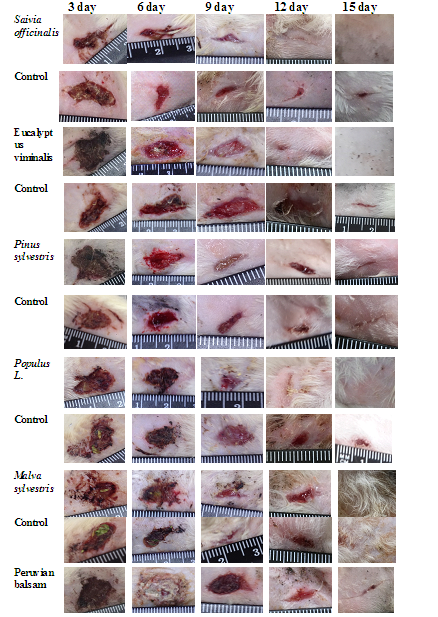
Figure 1. Photographic images showing healing pattern of wounds taken from same distance and in different days.
The time taken for the contraction of excisional wounds was calculated from the planimetric sheet photographs (Fig1). Control group showed the slow rate of wound contraction at various time intervals in post treatment with 50% ethanol-water compared to plant extracts. There was a significant increase in the percentage of wound contraction in group treated with Salvia officinalis compared to that of control on all days. Consistently, Eucalyptus viminalis and Populus L. treated groups showed faster healing rate on all the days, compared to the other treated and control groups. Malva sylvestris treated group did not show much variation, throughout the study. Nevertheless, the healing was much better compared to control. The rate of wound contraction in Malva sylvestris treated group showed slow increase and complete wound closure was observed on 17th day. Salvia officinalis and Pinus sylvestris treated wounds showed significantly improved rate of wound contraction from 9th day and complete closer of wound was observed on 15th day. On 12th day of the experiment Eucalyptus viminalis and Populus L. treated groups showed a complete closure of wound, 3 days ahead of group treated with Salvia officinalis and Pinus sylvestris and 6 days ahead of control. Complete healing of the groups treated with Eucalyptus viminalis and Populus L took 12 days, whereas, it took 15 and 17 days for the groups treated with Salvia officinalis, Pinus sylvestris, Malva Sylvestris respectively, control groups has taken 18 days for complete healing. In positive control dress from Peruvian balsam complete closer of wound observed on 15th day. The healing of the wounds in control and experimental groups were evaluated by microbiological analysis.
Microbiological analysis, total number of microorganisms
The Diagrams below depicts the variation of microflora number (x105) in excisional wounds at different days treated with composite dressings with different plant extracts. In first diagram we can see wound treated with Eucalyptus viminalis extract with CRH, the bacterial colony number at 3d day was slight over 25×105 and positive control with Peruvian balsam, negative control 1, negative control 2 and negative control 3 showed the same numbers on 3d day of treatment. The number of microorganisms decreased gradually day by day in all wounds including control wounds but wound treated with Eucalyptus viminalis showed lowest number compared to control wounds, on 6th day the number of bacterial colony reached to 15×105, followed by 9th day colony number dropped to 5×105 and 0 colonies on 12th day. While negative control 2 and 3 on 12th day still had around 8×105 bacterial colony and positive control with control 1 has showed on 12th day approximately 2,5×105 colonies.
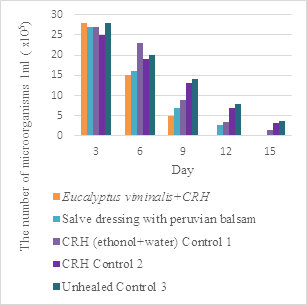
Figure 2. Diagram shows microorganism numbers in wounds treated with biocomposite from Eucalyptus viminalis extract with CRH and its controls.
Figure 3 shows the results of wound treated with biocomposite from Populus L. extract with CRH, the results are very similar to wound treated with Eucalyptus viminals extract with CRH. From 25×105 number of microbial colonies on 3d day, it has dropped to 10×105 microbial colonies on 6th day, followed to half of the numbers on 9th day. It showed 0 microbial colonies on 12th day, which shows that Populus L. extract has strong antibacterial activity.
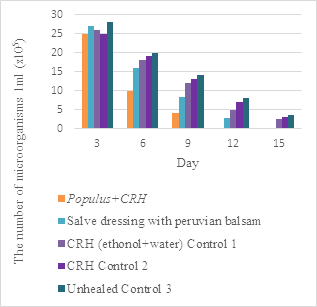
Figure 3. Diagram shows microorganism numbers in wounds treated with biocomposite from Populus L. extract with CRH and its controls
Figure 4 illustrates wound treated with biocomposite from Salvia officinalis extract with CRH. Number of microorganisms started from 30×105 on 3d day alone with controls and it dropped to 15×105 colonies on 6th day with little difference from controls. However on 9th day the number of microorganisms dropped to almost 5×105 bacterial colonies together with positive control Peruvian balsam, while in negative controls number of microorganisms was twice more. On 15th day biocomposite dressings from Salvia officinalis extract and CRH has showed 0 colonies together with positive control.
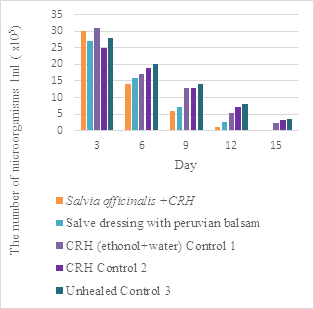
Figure 4. Diagram shows microorganism numbers in wounds treated with biocomposite from Salvia officinalis extract with CRH and its controls
Figure 5 shows results of biocomposite from Pinus sylvestris extract with CRH. The results are similar to Figure 4 with only difference on 15th day; some colonies still remained in wound treated with Pinus sylvestris extract with CRH, compared to positive control. Peruvian balsam has showed 0 colonies on 15th day while wound treated with Pinus sylvestris extract containing biocomposite dressing still contained some bacterial colonies.
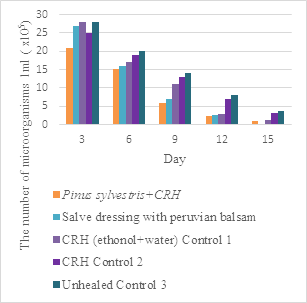
Figure 5. Diagram shows microorganism numbers in wounds treated with biocomposite from Pinus sylvestris extract with CRH and its controls
Figure 6 wound treated with biocomposite from Malva sylvestris with CRH. The results show that on 3d day it started with microorganism number 30×105 equal with controls and on 15th day the number of microorganisms decreased to approximately 2,5×105 still equal to negative controls while positive control was 0 on 15th day.

Figure 6. Diagram shows microorganism numbers in wounds treated with biocomposite from Malva sylvestris extract with CRH and its controls.
Thus, the results clearly show that Eucalyptus viminalis and Populus L. extracts possess the strongest antibacterial activity as was indicated in previous studies. On the other hand Salvia officinalis and Pinus sylvestris extracts showed moderate influence on bacterial growth and still having ability to kill most pathogenic bacteria. Unfortunately, Malva sylvestris extract did not show any antibacterial activity, although in previous studies it was indicated that this plant possess good antibacterial activity. The different results might be due to origin of the plant.
In conclusion, Eucalyptus viminalis, Populus L, Salvia officinalis and Pinus sylvestris plants that grow in the territory of Kazakhstan and Russia possess great antibacterial activity against wound pathogenic bacteria. The extracts of these plants should be further analyzed to isolate the specific antibacterial principles in them.
Biocomposite wound dressing from plant extracts and CRH was found to satisfy various ideal wound dressing characteristics like moisture maintenance, water absorption and protection from secondary infections proving their wound dressing potential.
References
- Annan K., Houghton P.J., Antibacterial, antioxidant and fibroblast growth stimulation of aqueous extracts of Ficus asperifolia and Gossypium arboreum L., wound-healing plants of Ghana. Journal of Ethnopharmacology, 2007, 119: 141-144.
- Archer G.L., Clin. Infect. 26 (1998) 1179–1181.
- Bernat Vanaclocha., , Fitoterapia :Vademécum de Prescripción Cañigueral Folcara V 02-05/06
- Chang H.Y., Yun H.P., Chong R.P., Effects of pre-carbonization on porosity development of activated carbons from rice straw // Carbon. — 2001. — Vol. 39, №4. — P. 559-567.
- Falanga V., Faria K., Robert L., Joseph V., Bioengineered skin constructs, in: Principles of Tissue Engineering, third ed., Academic Press, Burlington, 2007, pp.1167–1185.
- Houghton P.J., Hylands P.J., Mensah A.Y., Hensel A., Deters A.M., J. Ethnopharmacol. 100 (2005) 100–107.
- Jayakumar R., Prabaharan M., Sudheesh K.P.T., Nair S.V., Tamura H., Biotechnol.Adv. 29 (2011) 322–337.
- Leaper D. J., Silver dressings: their role in wound management. Int Wound J. 2006; 3:282-294.
- Махлаюк В.П., Лекарственные растения в народной медицине 1992. 594стр “M.: Нива-Росии”
- Purna S.K., Babu M., Traditional medicine and practices in burn care: need for newer scientific perspectives. Burns, 1998 , 24: 387-388.
- Shoba Jhadhav, Value Added Products from Gasification – Activated Carbon». The Combustion, Gasification and Propulsion Laboratory (CGPL) at the Indian Institute of Science (IISc). Retrieved 2015-04-30.
- Singer A.J., Clark R.A., N. Engl. J. Med. 341 (1999) 738–746.
- Zamyrbek F.Z., Zhusipova D.A., Zulpuhar A., Tastambek K.T., Karibayev E.K., Abdullayeva B., In vivo investigation of wound dressing based on carbonized rice husk with silver ions, KazNU Bulleten, Ecology series №1/1(43) Almaty, 2015
- Zulkhair Mansurov, Ilya Digel, Makhmut Biisenbaev, Irina Savitskaya, Aida Kistaubaeva, Nuraly Akimbekov and Azhar Zhubanova, Heterogeneous Composites on the Basis of Microbial Cells and Nanostructured Carbonized Sorbents, DOI: 10.5772/47796[schema type=»book» name=»WOUND HEALING POTENTIAL OF COMPOSITE DRESSING FROM NANO-SORBENT CARBONIZED RICE HUSK WITH TRADICINAL MEDICINAL PLANT EXTRACTS» description=»Open wounds require proper dressings for faster healing and to prevent infection. Today markets offer large number of dressings and plant extracts have been used in conventional treatment for a long time, but delivery method of the plant extracts to the purulent wound by efficient sorbent has not been studied well. The present work evaluates wound healing activity of ethanol-water extracts of Malva sylvestris, Pinus sylvestris, Populus L, Salvia officinalis and Eucalyptus viminalis impregnated to a new sorbent carbonized rise husk (CRH). Wound healing activity of composite dressing were determined by microbiological analysis of wound in vivo model, using Peruvian balsam as positive control, open unhealed wound and 50% ethanol water as negative control. All plant extracts were compared with positive control and negative control, also with each other. The microbiological analysis of the healing process shows significant differences in treatment, particularly on its intensity and rate. The results indicate that plant extracts of Eucalyptus viminali, Populus L possess good antibacterial and wound healing activity compared to other plant extracts and controls. Pinus sylvestris and Salvia officinalis healing capacity is less compared to Eucalyptus viminali and Populus L. but still better than control dressings. This work clearly demonstrates that Eucalyptus viminali, Populus L., Pinus sylvestris, Salvia officinalis extracts have wound healing activity. Biocomposite from Eucalyptus viminali, Populus L. and CRH showed to be the most effective to induce healing activity.» author=»Zhakenova Galiya Gaibullaevna, Zhussipova Dinara Abaihanovna, Zhubanova Azhar Ahmetovna» publisher=»БАСАРАНОВИЧ ЕКАТЕРИНА» pubdate=»2016-12-25″ edition=»euroasian-science.ru_25-26.03.2016_3(24)» ebook=»yes» ]

